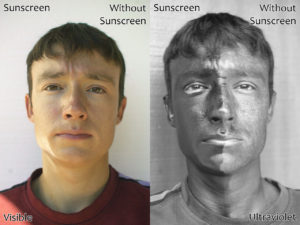
Summertime is well underway, and you may find yourself lathering on sunscreen more often – or like me, you may forget you even have a bottle sitting in your bathroom cabinet. But, there are many reasons to keep that bottle within reach.
Sunscreen is particularly important for those with certain skin types. The Fitzpatrick scale is a numerical classification of skin types that have varying responses to sunlight. For example, type I skin is pale/fair that almost always burns and never tans, while type IV mostly tans and rarely burns. However, no matter your skin type, we are all susceptible to sunburns given enough sun exposure.
What causes sunburns in the first place? The same culprit that causes tanning– more specifically, solar ultraviolet rays that reach earth. UVA (320-400nm wavelengths) is more prevalent than UVB (290-320 nm) and can reach deeper layers of the skin, but both types can wreak havoc. In skin cells (or keratinocytes), UV exposure induces DNA damage and increases oxidative stress. Tanning is a result of increased melanin production by skin cells (or melanogenesis), which absorbs UV rays. The long-term effects of UV damage on our skin is also known as photoaging – irregular, spotty pigmentation, wrinkling, sagging, and dryness just to name a few. (check out this paper for more).

Sunscreen, like the name implies, blocks UV light from penetrating the deep layers of our skin through multiple active ingredients. Inorganic particulates such as zinc oxide and titanium dioxide are particularly effective at reflecting UVA and blue light. Other organic molecules absorb UV rays, such as aromatics. Newer brands of sunscreen include compounds such as avobenzone, Helioplex, and Meroxyl SX – all are not only safe, but also beneficial to blocking UV rays on the skin.
Something else to know about sunscreen – that SPF (Sun Protection Factor) written in huge numbers on your bottle means something after all! Officially, it is a measure of the fraction of sunburn-producing UV rays that reach the skin. For example, SPF 15 means that 1/15th of burning radiation from the sun will reach the skin assuming the correct (i.e. thick) dose of sunscreen is applied. So, if you’re Fitzpatrick scale type I skin, it’s likely that you will get a sunburn from one application of SPF 15 sunscreen while your friend, who is type III or IV, does not burn with the same application.
Here are a few tips about picking and using the right sunscreen –
- According to the American Academy of Dermatology, look for a sunscreen that has an SPF of 30 or higher that provides broad-spectrum coverage against both UVA and UVB light. The FDA recommends a broad-spectrum sunscreen with SPF 15 or higher.
- Apply sunscreen anytime you go outside. UV light can still penetrate the atmosphere during cloudy days or in the winter!
- Use the right dose. For an average adult, use at least 1 ounce (about what you can hold in your palm, or in a single shot glass) for all sun-exposed skin.
- Re-apply every 2 hours to remain protected.
- Check that expiration date. The active ingredients in sunscreen degrade slowly over time, and even though newer sunscreens have stabilizers be sure to replace your sunscreen if it’s expired.
Peer edited by Christina Marvin.
Follow us on social media and never miss an article: